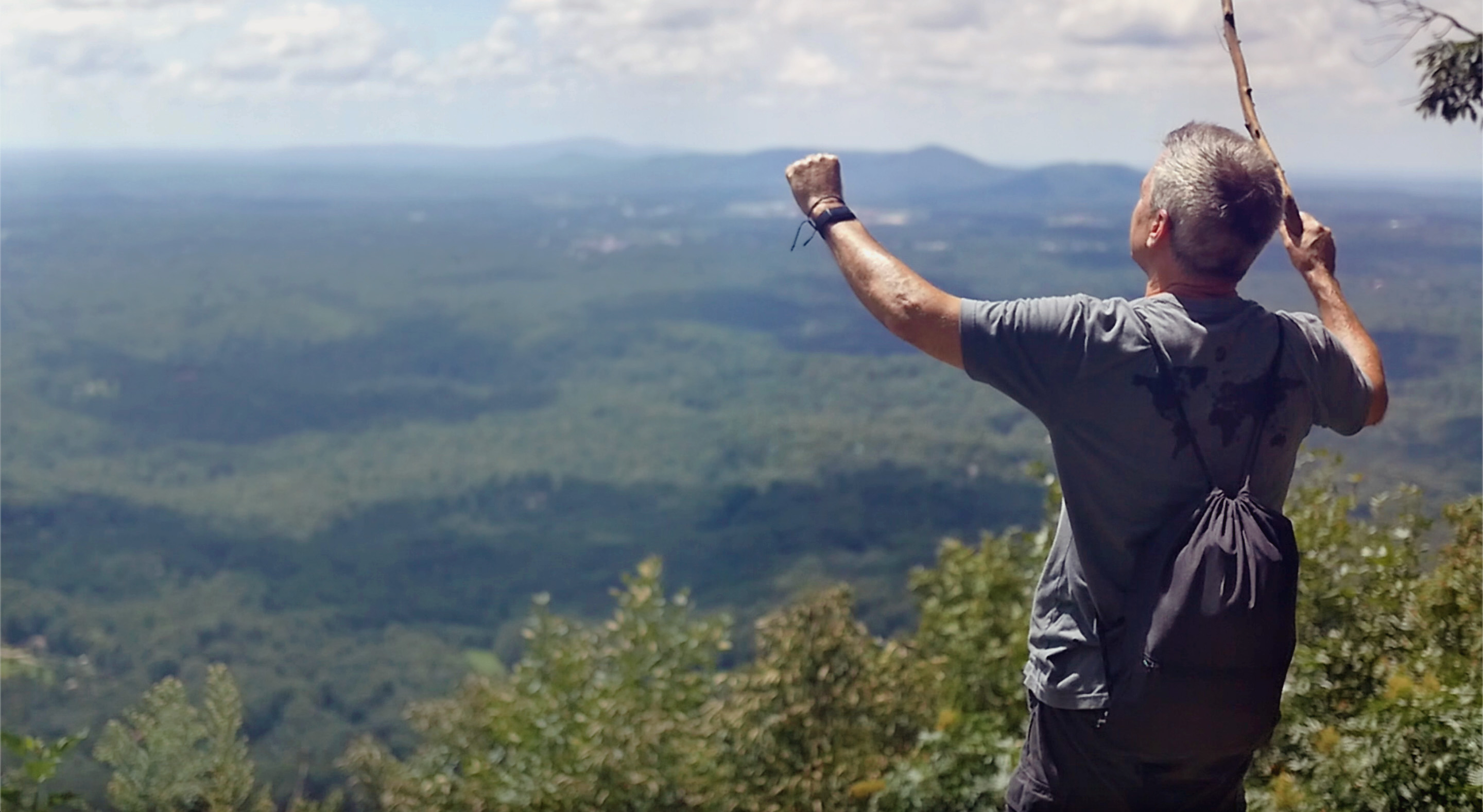Personal Story: Patient Climbs to the Top After Heart Diagnosis
Heart HealthPosted:
 Stephen Hilfiker celebrates reaching the top of Sharp Top Mountain.
Stephen Hilfiker celebrates reaching the top of Sharp Top Mountain.
Sometimes, you just do something and ask for forgiveness later. For Stephen Hilfiker, that meant hiking to the top of Georgia’s Sharp Top Mountain just 90 days after receiving a heart transplant.
Stephen credits Lee Health’s Cardiac Rehabilitation for helping him reach that mountain top.
He says his accomplishment “was my moment of recovery, the moment I knew I was back.”
It was a moment that hardly seemed possible when Stephen was diagnosed in June 2020 with cardiac sarcoidosis, a rare heart condition that had left him dying from heart failure in a hospital and waiting for a heart transplant.
Sarcoidosis develops when groups of cells in your immune system form red and swollen lumps, called granulomas, in various organs in the body, according to the National Institutes of Health.
The inflammation that leads to these granulomas can be caused either by infections or by certain things you come into contact within your environment.
The disease can cause permanent scarring (fibrosis) in the lungs or other organs and can lead to life-threatening heart or lung problems. In Stephen’s case, the inflammatory disease affected his heart (cardiac sarcoidosis).
According to Cleveland Clinic, cardiac sarcoidosis is diagnosed in 2 percent to 5 percent of people who have sarcoidosis elsewhere in their bodies. Between 20 percent and 30 percent of Americans with sarcoidosis may have it in their hearts. Severe cases of cardiac sarcoidosis can lead to heart failure.
Troublesome symptoms
For Stephen, his symptoms puzzled doctors for many years. The debilitating symptoms included frequent bouts of dizziness, nausea, dry heaves, and shortness of breath.
“It took five years to actually get a diagnosis from my first symptoms,” Stephen recalls. “During that time, it progressed and led to my heart failing. When you have heart failure, and it’s progressive, slow, and chronic, you don’t know how sick you feel cause it’s so gradual. You don’t notice you’re getting sicker and sicker every day.”
When doctors made the diagnosis in June 2020, Stephen learned he had five weeks to live if he didn’t get a heart transplant. Things progressed quickly, and two months later, Stephen had a heart transplant at an outside facility and then began cardiac rehabilitation in September at Lee Health’s HealthPark Medical Center.
For 12 weeks, Stephen’s heart function was carefully monitored while he exercised under full medical supervision. His care team included doctors, nurses, exercise physiologists, and a dietitian. The all-encompassing program focused on weight training, cardio, and education about heart health and nutrition.
“Basically, it got my physical fitness back,” Stephen says. “That physical therapy led to my complete rehabilitation. The nurses here took such great care of me. They motivated and inspired, but also safely pushed me to my limits.”
No sooner had Stephen finished his cardiac rehab program when he drove to Jasper city in northeast Georgia to hike 1,100 feet into the sunshine at Sharp Top Mountain. He didn’t tell his cardiac team about his plans, either.
“I didn’t ask for permission because I knew I wouldn’t get it,” he says. “It was a totally personal and somewhat spiritual decision. I knew I could do it, and I knew I was ready. I had to do it for myself to prove that I was back, alive and well.”
When Stephen breathed in that crisp mountain air at the top, he knew it was the moment of victory. He remembers what his youngest son said to him afterward.
“Dad, you just showed me I can do anything,” he says. “That’s the most powerful thing a father can hear.”
Two years later, Stephen says he feels great. He often works out twice a day. A corporate executive before his heart transplant and recovery, he has reinvented himself as an advocate for sarcoidosis, organ donation, and heart transplant survivors.
Stephen’s new calling also includes a documentary he produced about sarcoidosis with his nephew, a filmmaker. The film debuted at the Cannes Film Festival in early summer.
The most important lesson for patients, he said, is even after seeing a doctor, if something isn't right, push for answers.
“I wouldn’t be here if I hadn’t advocated for myself,” he says. “I was kept alive for a reason.”
Technology and Expertise at Lee Health
The Lee Health Cardiac Rehabilitation program offers patients the most advanced cardiac rehabilitation facility in Southwest Florida. Our Cardiac Rehab Phase 2 programs are certified by the American Association of Cardiovascular and Pulmonary Rehabilitation (AACVPR).
We also provide a dedicated and highly trained staff. Our team works closely with your physician and includes medical professionals from a variety of disciplines who understand the challenges of living with heart disease. They will teach you how to meet those challenges.
The Largest Heart Program in Southwest Florida
The Lee Health Heart Institute has an alliance with Cleveland Clinic’s Heart, Vascular & Thoracic Institute, the nation’s leader in heart care. Cleveland Clinic, one of the most trusted names in healthcare in the U.S., elevates medical care in Southwest Florida by opening up possibilities for future collaboration, programs, and activities that will enhance the exceptional service Lee Health already provides to our patients.
Our heart institute includes primary and specialty care, nationally ranked hospitals, Shipley Cardiothoracic Center, cardiac rehabilitation, and more. HealthPark Medical Center has been recognized as a PINC AI Fortune 50 Top Cardiology Hospital in the country - and 1 of only 4 hospitals recognized in the state of Florida.
Find a Lee Health cardiologist expert here.

